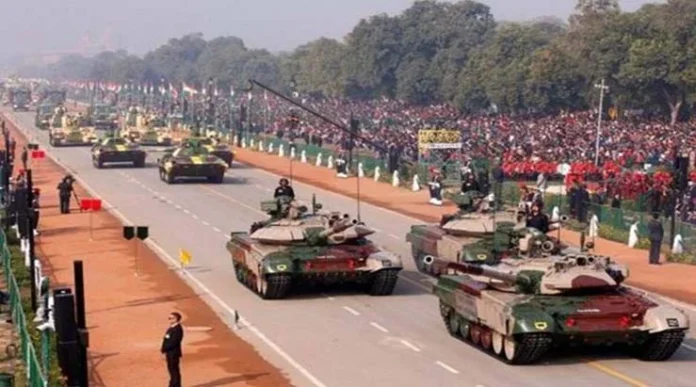India has emerged yet again as the largest importer of arms, concurrently sliding back in exports. It exposes the vacuity of the official hype over rising levels of local manufacturing and the spurt in defence exports to more than 75 countries across the globe.
According to the report entitled Trends in International Arms Transfers, 2022, published in March 2023 by Sweden’s Stockholm International Peace Research Institute (SIPRI), India accounted for 11 per cent of the global imports between 2018-22, down from its 12 per cent share in the preceding four-year block of 2013-17.
Parallelly, in an embarrassing blow to the claims of soaring defence exports from India, it does not figure anymore among the 25 largest exporters – a league it had broken into in 2015-19 with 0.2 per cent share of the global export market, which is also the highest share India managed to garner before being edged out of the league.
In 2020, the Ministry of Defence (MoD) had set the twin targets of ramping up local defence manufacturing to Rs 1,75,000 crore, and exports to Rs 35,000 crore, by the year 2024-25. These targets continue to be projected as the cornerstone of the country’s quest for self-reliance in defence production, despite achieving these targets becoming tougher by the year.
Replying to a question in the Rajya Sabha on February 13, Minister of State for Defence Ajay Bhatt disclosed that the value of production by the private and public sector defence units had increased from Rs 78,820 crore in 2017-18 to Rs 94,846 crore in 2021-22. This amounts to a compound annual growth rate (CAGR) of merely 4.74 per cent.
For sure, the economic disruption caused by the Covid-19 pandemic slowed down manufacturing during this period, especially in 2019-20 when it slumped to Rs 79,071 crore, but the fact is that local production will have to grow at CAGR of approximately 16.5 per cent between 2022-23 and 2024-25 to reach the target of Rs 1,75,000 crore.
In a broad sense, MoD’s strategy to achieve the aforesaid targets is built around several policy initiatives taken in the past 8-9 years and major revisions of the procurement procedures in 2016 and 2020. While all these steps were intended to promote Make in India, which also lies at the heart of Aatmanirbharta, or self-reliance, in defence, two developments stand out.
First, the policy adopted in 2016 made it mandatory to accord the highest priority to procurement of defence equipment designed and developed by the Indian companies, and the second priority to equipment manufactured locally with transfer of technology from the foreign original equipment manufacturers (OEMs). Outright import of equipment was to be the last resort.
Second, to encourage local manufacturing by the Indian industry, four ‘positive indigenisation lists’ have also been notified by the MoD since August 2020 to progressively ban import of 411 items which range from chaff rockets to military aircraft. The fifth list is believed to be under preparation. These lists provide a preview of the armed forces’ future requirements to the Indian industry in a bid to encourage local manufacturing of the banned-for-import items.
Some other important initiatives include relaxation in the foreign direct investment norms, which currently allow investment up to 74 per cent through the automatic route and beyond that with the government nod, setting aside 25 per cent of the R&D budget for the private sector, and earmarking a substantial portion of the capital budget – 75 per cent for the financial year 2023-24- for procurement from the local industry.
It would be legitimate to ask why, despite all these measures, local manufacturing hasn’t gathered momentum. To be fair, some of the measures, like the embargo on imports, are too recent to start showing results but whether they can collectively propel local defence manufacturing to Rs 1,75,000 crore mark by 2024-25 is the moot point.
One of the many problems plaguing defence manufacturing has been the enduring inadequacy of capital outlay, which limits MoD’s capacity to buy and, in turn, the industry’s ability to ramp up production. Prima facie, this problem has been overcome in the budget for 2023-24, but a closer look at the fine print suggests otherwise.
According to a March 2023 report of the Standing Committee on Defence, for the year 2023-24, the Indian Army (IA) and Indian Navy (IN) have been allocated whatever they had demanded for capital expenditure, and the gap between the Indian Air Force’s (IAF’s) projection and budgetary allocation is a mere Rs 539.77 crore. This is creditable but it cannot be concluded that this seemingly satisfactory allocation will result in substantially higher procurement by the MoD.
For one thing, the amount demanded by the IA and IAF for 2023-24 was the lowest since 2018-19, and the IAF’s demand was the lowest since 2021-22. This implies that the armed forces do not have substantially higher allocation at their disposal in 2023-24 for signing new contracts. And for another, as in the past, a large proportion of the allocated budget will undoubtedly be spent on making contractual payments against previously concluded contracts, further impacting the ability to award new contracts.
Local manufacturing can gather pace only in proportion to the increase in the armed forces’ capacity to buy which remains very modest despite their budgetary requirements being met in full. In the circumstances, policy measures such as earmarking 75 per cent of the capital budget for procurement from the local industry or putting an embargo on import can contribute little to achieving the production target set for 2024-25.
Reaching the export target of Rs 35,000 crore seems to be an equally uphill, albeit not an impossible, task. Recent media reports indicate that the value of exports in 2022-23 was Rs 15,900 crore. This is more three times the exports worth a mere Rs 4,682 crore in 2017-18, but the increase has not been steady.
As a matter of fact, after a sudden jump from Rs 4,682 crore in 2017-18 to Rs 10,746 the next year, exports came down to Rs 9,116 crore and Rs 8,435 in the following two years, before jumping again to Rs 12,815 crore in 2021-22. This fluctuation, undoubtedly caused in part by the Covid-19 pandemic, makes it uncertain that the exports will jump to Rs 35,000 mark by the next year end on their own steam.
There are other factors too. One, the global defence export market is dominated by just a handful of countries. Almost three fourths of the export is monopolised by the United States (40 per cent), Russia (16 per cent), France (11 per cent), and China (5.2 per cent). Most of the remaining trade is dominated by another 20 countries with their individual shares ranging from 0.2 per cent to 4.2 per cent.
India will have to break into this tightly controlled market, which is not going to be easy, not least because India does not have a wide range of major military equipment to offer. Moreover, except for the US whose exports are staggered across several countries, the other major exporters have two or three countries each which account for a major proportion of their exports. According to the latest SIPRI report, 63.2 per cent of Russia’s exports in 2017-21 were to India (31 per cent), China (23 per cent) and Egypt (9.2 per cent). Likewise, India (30 per cent), Qatar (17 per cent) and Egypt (8 per cent) account for 55 per cent of France’s export, while Pakistan alone accounts for 54 per cent of China’s total export.
On the other hand, India had Myanmar as its biggest customer during 2017-21 with a share of 50 per cent, followed by Sri Lanka (25 per cent) and Armenia (11 per cent). Though the percentages seem formidable, these countries have limited resources and transient demand to catapult India into the big league of exporters on a lasting basis. India will need one or two major customers to sustain its exports.
All said and done, it may not be impossible to achieve the production and export targets set out for 2024-25 even in the face of several challenges, but the policy makers and strategists in the MoD have the work cut out for themselves to deal with these challenges and evolve appropriate strategies to deliver on the pledge.
– The writer is a Ex-Financial Advisor (Acquisition), Ministry of Defence
–The writer is a former Financial Advisor (Acquisition), Ministry of Defence. The views expressed are personal and do not necessarily reflect the views of Raksha Anirveda






